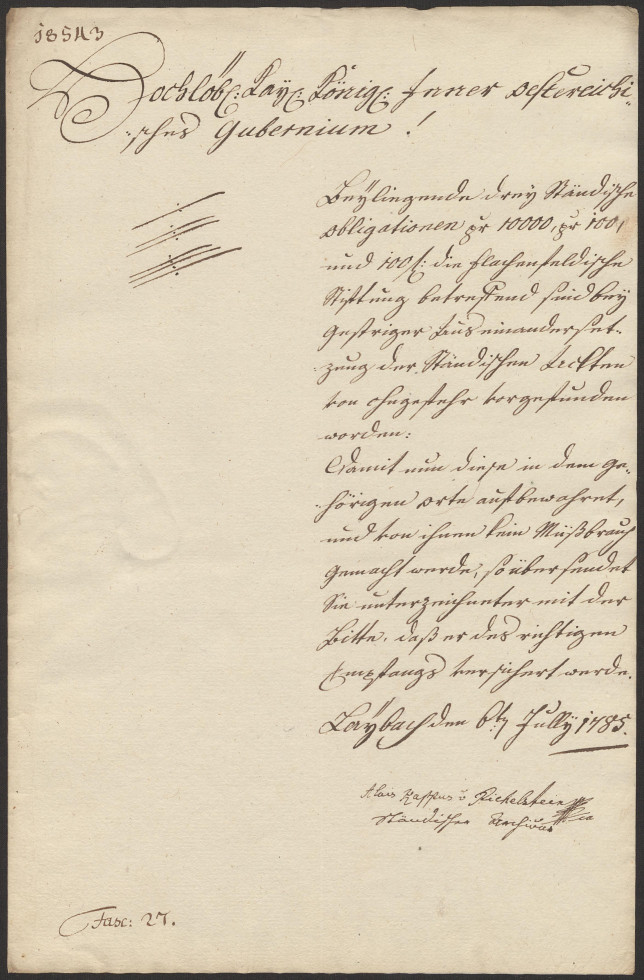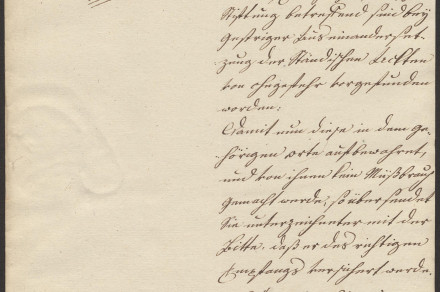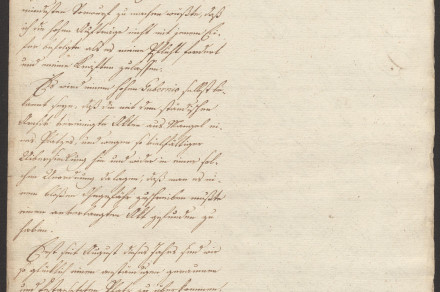The Condition of the Carniolan Provincial Estates' Archive in 1785 According to the Writings of its Archivist Alois Kappus von Pichelstein
Ljubljana, July 6 and December 6, 1785
Original, paper, 2 documents (1 and 3 pages)
Reference code: SI AS 14, Gubernij v Ljubljani, reg. I., fasc. 27, Cerkvene zadeve, duhovne in svetne ustanove, Flachenfeldov kanonikat, box 12

A letter by the Carniolan Provincial Estates' archivist Alois Kappus von Pichelstein to the Inner Austrian Gubernium in Graz, July 6, 1785. | Author Arhiv Republike Slovenije
In 1783, Alois Kappus von Pichelstein began his work as the archivist at the Carniolan Provincial Estates' archive, the first employee ever to hold this title, and remained at his post until 1788. He took over at the time when Emperor Joseph II decided to reduce the number of provincial authorities in the hope of centralising the Monarchy. Carniolan provincial authorities (Landeshauptmannschaft) were thus dissolved and Carniola was incorporated into the Inner Austrian Gubernium in Graz. To provide this newly established Gubernium with some of the material it needed to start, Kappus, when first employed, had to prepare and send to Graz some of the archive’s more current records. To add to his work, in 1785, the Estates’ archive also acquired the archives of the former Jesuit order and of the dissolved abbey in Stična.
The two documents presented here as this month’s archivalia refer to the arrangements of matters concerning the founding charters of the Flachenfeld’s canonry at the Cathedral of Ljubljana. They at the same time provide a glimpse of the challenges that awaited Kappus when arranging and processing the Estates’ archive, which at the time was located at the palace occupied by the Provincial Estates for Carniola.
In order to carry out the reforms introduced by Maria Theresa and Joseph II, the authorities made the decision to bring more order and control in the way secular and religious foundations were being managed. To achieve this, they requested to be sent the missing founding charters and proof of capital for various foundations. The Inner Austrian Gubernium demanded and in July 1785 received from Kappus the proof of capital for the Flachenfeld’s canonry at the Cathedral of Ljubljana – three bonds issued by the Provincial Estates for Carniola worth 10,200 gulden. Archivist Kappus reported that he had no trouble finding the bonds and was now sure that they were in their proper place and safe from any abuse. Still, he asked for the confirmation of the receipt. The Gubernium confirmed receiving the bonds and requested Kappus to also find other documents related to the establishment of the canonry.
Here, however, it got a bit tricky. It took Kappus almost six months, until December 1785, to actually find the founding charter. In his defence, he sent to the Gubernium a description of the condition the archive was in, and reported on some of the challenges he was faced with in the course of his work.
As a way of introduction, he stated that he would have consider himself as someone deserving of punishment, if there had been even a slightest trace of reproaching himself for failing to carry out his task with all due diligence and as his duty dictated and his strength allowed. He also stated that due to the lack of space and numerous moving about, the documents were in such state of disorder that it was by pure coincidence that one could even find a single document. It was not until 1785 that the archive had had a good fortune to actually be allocated a suitable space for its work. Kappus went straight to work and reported that most of the documents were now arranged and managed as they should be. He would have finished the work if the rest of the documents had not been in such obvious state of disarray and had to be registered anew by Kappus, who now had to do twice as much work, in addition to the abundance of other office work.
As the frequently requested founding charter of the Flachenfeld’s canonry was among this mass of previously unregistered documents, and Kappus was only able to locate it by putting in a lot of effort, he hoped that the Gubernium would be able to overlook his delay, particularly because he would no longer use such excuse in the future, seeing that most of the archival documents were now kept in order.
He concluded by adding that due to the major delay he would not dare to keep the founding charter a bit longer and make a transcription of it. Instead, he would like to ask the Gubernium to arrange for the transcription of the charter and for sending it to him, so that he can complete the Estates’ archive collection. If, however, the obtaining of the transcript was not possible, Kappus asked if Gubernium could at least confirm that they had received the charter, so that he would have evidence that the charters were now kept in Graz.
Andreja Klasinc Škofljanec
- SI AS 14, Gubernij v Ljubljani, reg. I., fasc. 27, Cerkvene zadeve, duhovne in svetne ustanove, Flachenfeldov kanonikat, box 12
- Nared, Andrej: Arhiv kranjskih deželnih stanov. Arhivi, vol. XXIV, 2001, no. 2, pp. 1–17.
- Radics, Peter von: Das Archiv der krainischen Landschaft. Laibacher Zeitung, No. 209, 1862, p. 1158.
- Žontar, Jože: Struktura uprave in sodstva od srede 18. stoletja do leta 1848. Ljubljana: Arhiv RS, 2008, pp. 95–100.


